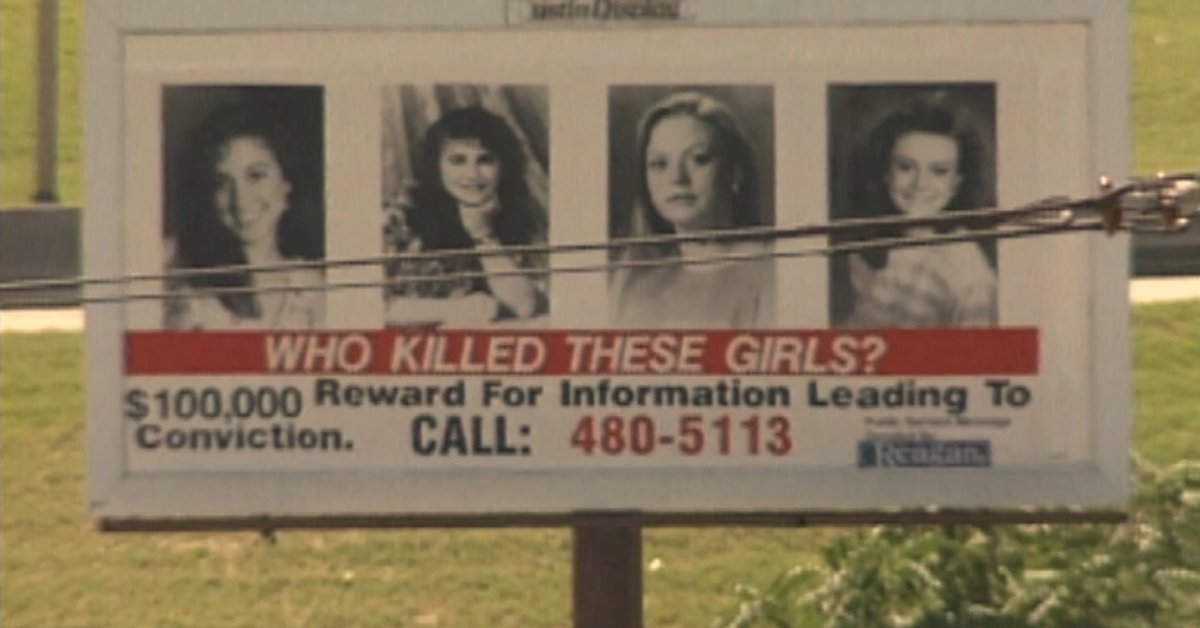Thirty-three years ago, what was meant to be a sweet trip to a frozen yogurt shop in Austin, Texas, turned into a tragedy when four girls were fatally shot on Dec. 6, 1991.
Amy Ayers, Jennifer Harbison, Sarah Harbison, and Eliza Thomas, all teenagers between the ages of 13 and 17, were killed and stripped of their clothing in a room in the back of the shop, before the place was set on fire. The case, which has remained unsolved for decades, is the subject of a new HBO documentary, The Yogurt Shop Murders, directed by Margaret Brown.
In four episodes, premiering Sundays starting Aug. 3, the series explores all of the possible theories about who murdered the girls. It features interviews with investigators—and their interviews with the suspects—the victims’ family members, and rare footage of the suspects filmed by a local Austin documentary filmmaker, Claire Huie. Exactly why these four girls were murdered is still unknown.
“I would be at parties, and people would just start talking about the yogurt shop murders,” Brown, an Austin native, says. “It’s part of the mythos of Austin, part of the collective memory, the fabric of the city. Everyone has a theory.”
Here’s what to know about the first episode of The Yogurt Shop Murders.
A key arrest
The first episode of The Yogurt Shop Murders opens with Huie’s footage of a man named Robert Springsteen going shopping for a suit at a Macy’s. He tells the salesperson he’s just gotten off death row and is looking for sharp clothes for an interview with CBS’s investigative show 48 Hours and various court appearances. The scene teases that viewers will learn how Springsteen became a free man in the next episodes.
He was named about a week after the shooting, when police arrested his friend, Maurice Pierce, 16, who was carrying a loaded pistol in the waistband of his jeans in the Northcross Mall Plaza near the I Can’t Believe It’s Yogurt! shop. It was the same type of gun that police were looking for since they found a bullet in a sink at the yogurt shop.
When Pierce was questioned, he did not admit guilt, but he gave up the names of other guys he had been hanging out with the night of the shooting: Michael Scott, Springsteen, and Forrest Welborn.
Pierce said Forrest asked to borrow his gun and came back sweaty and smelling of hairspray. The next day, the four boys stole a car and drove to San Antonio to see a girl, and when they returned, Maurice said Forrest asked for the gun again. When Maurice asked why, he said Forrest told him that he wanted to kill more girls like he did the night before.
Viewers will hear a police recording of Maurice asking Forrest point blank if he killed the girls, and Forrest claiming he was joking and assuring him, “I wouldn’t lie to you.” Police also never found evidence to prove he killed the girls.
The mess at the crime scene is one key reason why this case remains unsolved. Police did not have physical evidence to link these four boys to the crime, though they did make sure they got swabs from the girls for future DNA testing. There was no video footage at the store, and the crime scene was covered in water from extinguishing the fire, making it difficult to find fingerprints and evidence that are not contaminated. And while police could track credit card transactions at the store, they couldn’t track people who paid in cash.
The leading theory about the yogurt shop murders among law enforcement is that it was a robbery gone wrong.

Families still traumatized
In the first episode, the families of the victims recall Dec. 6, 1991, like it was yesterday. Eliza Thomas’s sister Sonora recalls her teeth chattering uncontrollably when she heard the news and having to put her hand in her mouth to stop her teeth from chattering. She remembers vividly the awkwardness of telling her divorced parents the news of their daughter’s death. Sonora remembers nervously cleaning the house while her mother locked herself in her bedroom, refusing to even come out and talk to the police. During her first night sleeping without her sister nearby, Sonora Thomas recalls thinking, “I’ve never woken up on a day when my sister wasn’t alive.”
Shawn Ayers misses his sister Amy every day, saying, “not one day that I don’t think of her.” Pam Ayers thinks of her daughter Amy every time she sees kids and animals, as Amy and the three other girls were part of Future Farmers of America.
Barbara Ayres-Wilson, mother of Jennifer and Sarah Harbison, has been speaking publicly about the murders since losing her daughters, hoping it would help law enforcement solve the case sooner. She recalls that Jennifer and Sarah were in such a good mood the day they died, excited to go to the yogurt shop, where Jennifer worked. She saw them off and got a hug from each of the girls and reminded them to be careful. And yet, she still wonders if there is anything she could have done differently, stating, “You just have all of these regrets of not protecting [them]…How could someone be and then not be?”








